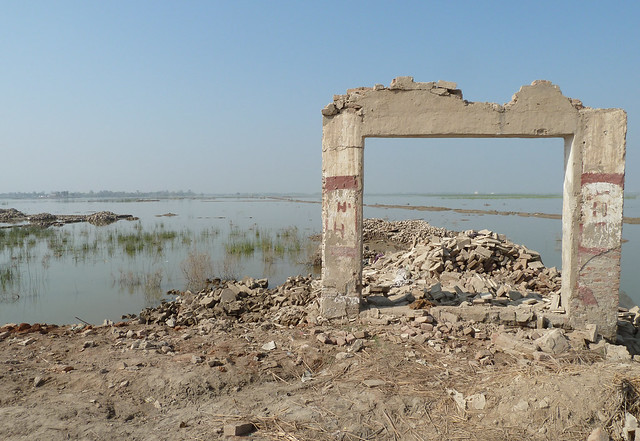Unusually heavy monsoon rains in July and August 2010 left large swaths of Pakistan underwater. At least 18 million people were affected by the flood, and it is estimated that, more than six months later, several hundred thousand remain without even temporary shelter. As a result of lost crops and livelihoods from the flood and inadequate relief supplies, malnutrition continues to kill people. Like most floods, the Pakistani poor have suffered far more than those with resources to avoid the flood, or at least its aftermath.

Remains of a school destroyed by flooding, near Jacobabad by UK Department for International Development, on Flickr. Used under a Creative Commons license.
A paper in press in Geophysical Research Letters shows that the 2010 floods were extraordinary. Monsoonal rains tend to occur in pulses, with multi-day wet periods followed by multi-day dry periods, and while the total rainfall over Pakistan during the 2010 monsoon season was not unprecedented, the number and intensity of extremely heavy rains over northern Pakistan was very unusual. The authors are working with very limited historical and satellite data, but they estimate that the number of intense rain bursts that occurred in 2010 had a probability of less than 3% in any given year.
Using data from the European Centre for Medium Range Weather Forecasts collection of meteorological models, the authors of the new paper show that the timing and intensity of northern Pakistan’s monsoon rain bursts are predictable up to 6 to 8 days in advance – including the rains that caused the flooding in 2010.
Lead author, Peter Webster, and his coauthors from the Georgia Institute of Technology, draw the following conclusion from their analysis:
We conclude that if these extended quantitative precipitation forecasts had been available in Pakistan, the high risk of flooding could have been foreseen. If these rainfall forecasts had been coupled to a hydrological model then the high risk of extensive and prolonged flooding could have anticipated and actions taken to mitigate their impact.
The floods really kicked off with a burst of rain on 28-29 July 2010, and according to Webster’s reanalysis, that rainfall was predictable with good skill 7 days in advance (21 July). Webster and colleagues argue that if that forecast was available in Pakistan, lives would have been saved and the immensity of the disaster reduced. But, C. Christine Fair, writing on the Foreign Policy magazine website suggests that the flood was forecast in Pakistan.
In the middle of July, the PMD began tracking a storm brewing in the Bay of Bengal. This eastern weather system developed interactively with a western weather system to produce the massive rains and the subsequent super flood of 2010. On July 24, the PMD issued a flood warning to the provincial government of Khyber-Pakhtunkhwa (KPK). Despite these increasingly severe warnings, KPK’s citizenry did not believe them. … The PMD kept issuing warnings to KPK as the rains began to fall. However, as fate would have it, on July 28, … a passenger jet coming to Islamabad from Karachi crashed …With the media beset upon this tragic spectacle, the PMD’s warnings went unheeded as the rain began to fall.
So the Pakistani government did forecast the flood – at least four days out – in plenty of time to get people in northern Pakistan’s valleys out of the way. The problem was not with the meteorological and hydrologic science either internationally or in Pakistan. Instead, disaster was ensured when flood warnings were not taken sufficiently seriously by regional authorities, media, and residents.
Why wouldn’t flood warnings be heeded? Perhaps more could have been done to communicate to Pakistanis through channels whose authority they respected. Webster cites an example of flood warnings in Bangladesh being disseminated by imams at local mosques. The Foreign Policy article quoted above places some blame on media distractedness.
But there was also a more insidious reason the forecasted flood was ignored. It was a rare event, but it was also part of a new climatic pattern for Pakistan. As the Foreign Policy article describes it:
in recent years there has been a slow but steady change in the location where Pakistan’s major rainfalls concentrate. In the past, monsoon rains fell most intensely over the Punjab. Slowly and steadily, the concentration of rainfall has moved north and west to KPK. This redistribution of concentrated rainfall away from the Punjab and towards KPK explains why no one in KPK had any reason to believe the predicted weather.
Flooding frequency and intensity have increased in Pakistan in the last 30-40 years compared to earlier in the 20th century. Webster and coauthors state, “This recent increase is consistent with the increase in intensity of the global monsoon accompanying the last three decades of general global warming.” The flood warnings were ignored, in part, because the statistics of monsoon rain patterns are changing. Human memory and historical records are not good guidance if the weather system is changing. In situations like this one, the past is not the key to the present.
There are lots of things that should have been improved to lessen the magnitude of the Pakistani flood disaster – reservoir management should have been altered; emergency relief supplies should have been distributed more equitably, broadly, and consistently; international assistance should have been much more generous – but the two big lessons for hazard mitigation coming out of the Pakistan floods seem to be: “find a system for making sure that warnings are issued and that they actually make it to people in harm’s way” and “don’t assume the climate of living memory is a very good indicator of the weather of the present and future.”
Webster, P. J., Toma, V.E., & Kim, H.-M. (2011). Were the 2010 Pakistan floods predictable? Geophysical Research Letters : 10.1029/2010GL046346



Comments (6)
Links (2)
-
-
Pingback: Listening to the Forecast : jfleck at inkstain
Pingback: Pakistan floods: Predictable or predicted, but a disaster nonetheless | ttl :: Time to Live